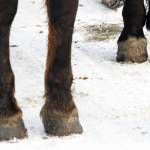Cryotherapy for Laminitic Horses

Laminitis remains a common and devastating condition that frequently results in long-term incapacitation, recurrence of disease, and even loss of life. While laminitis can’t always be predicted or avoided, sepsis-related laminitis secondary to colic, colitis, or uterine infections, for example, may be avoided with cryotherapy.
“Cryotherapy involves the controlled cooling of a horse’s hooves using either ice water or commercial systems. These wet forms of cryotherapy are particularly useful in preventing laminitis in at-risk horses,” explained Laura Petroski-Rose, B.V.M.S., a Kentucky Equine Research staff veterinarian.
Experts recommend beginning cryotherapy as soon as possible, preferably prior to or at onset of lameness, and cooling the hoof wall to 5–10° C (41-50○ F) for either 48-72 hours or until resolution of clinical signs of infection.
While widely accepted as a gold standard in the prevention of sepsis-related laminitis, concerns surrounding the procedure exist. These include:
- Challenges associated with implementation, considering how labor-intensive the procedure is;
- Appropriately restricting patient mobility to effectively cool the hooves;
- Having access to a suitable supply of ice;
- Cost of the equipment if commercial systems are used; and
- Safety to the patient.
“These horses could potentially have one or more feet in direct contact with very cold ice water for several days. Despite the overall perceived efficacy, some adverse events have been reported in association with wet cryotherapy protocols,” Petroski-Rose warned.
Recently, equine veterinarians reviewed the medical records of 285 horses that underwent wet cryotherapy for a minimum of 12 hours. They found that, overall, only 7% of treated horses sustained tissue injury to the treated limb. Lesions observed included inflammation of the skin and underlying tissues (dermatitis, cellulitis, coronitis), hair loss, tissue necrosis (death), and distal limb swelling.
“These lesions were similar to frostbite, nonfreezing cold injury, and prolonged water immersion injuries seen in other species,” wrote the veterinarians.
The longer a horse underwent cryotherapy, the more likely it was to develop a treatment-related issue. Despite the low occurrence of cyrotherapy-related issues, any horse undergoing this therapy should be closely monitored. The veterinary research team also noted that “further studies to improve safety, efficacy, and convenience of alternative methods of digital cryotherapy for horses are warranted.”
“Proper nutrition designed to support overall health and prevent foot problems as well as maintenance of an appropriate body condition score will help minimize the development of laminitis,” advised Petroski-Rose.
She adds, “Consult a Kentucky Equine Research nutrition advisor today to discuss your horse’s needs. Be sure to ask about Bio-Bloom PS, a nutritional supplement containing biotin, methionine, iodine, and chelated zinc to improve hoof growth and strength.”
In Australia, look for Bio-Bloom HF.
*Proctor-Brown, L., R. Hicks, S. Colmer, et al. 2018. Distal limb pathologic conditions in horses treated with sleeve-style digital cryotherapy (285 cases). Research in Veterinary Science. 121:12-17.








